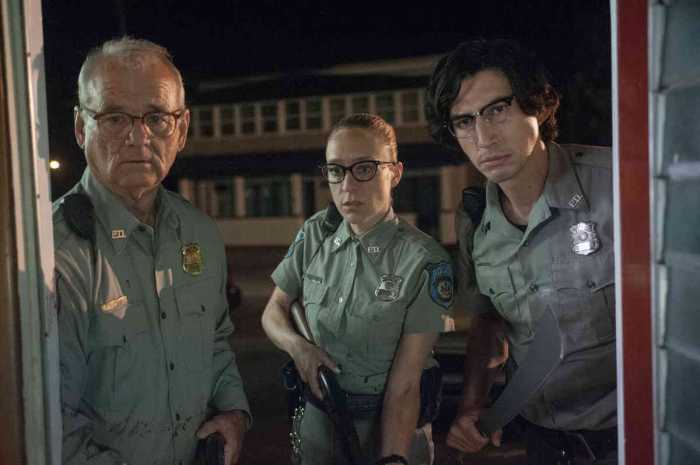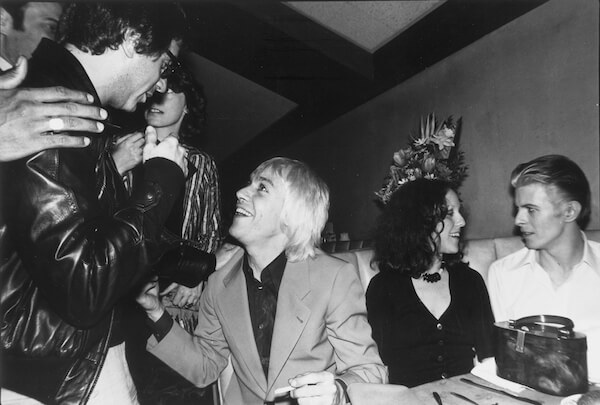Iggy Pop (center) and the Stooges. | AMAZON STUDIOS & MAGNOLIA PICTURES
“Gimme danger, little stranger,” sings the Stooges’ Iggy Pop on the song that lends its title to Jim Jarmusch’s documentary on the band. He was probably thinking of an exciting sexual encounter, but the power of the Stooges’ music is so primal that it suggests something a whole lot more serious and sinister. Danger to the Stooges themselves, first and foremost.
Original bassist Dave Alexander passed away of pneumonia in 1975, and today Iggy is the sole survivor from the band’s original lineup. That taste of danger would prove intoxicating to future musicians – Jarmusch includes a montage of various punk bands covering Stooges songs in the late ‘70s – but it drove away hippie audiences who, in 1969, the year of Woodstock, didn’t want to hear there was really nothing to do, as the first song on the first Stooges album says. If you were a working-class teenager stuck in Michigan, however, the ‘60s no doubt looked a whole lot less exciting.
Jarmusch has always been an unconventional director, but never a flashy one. His Neil Young doc “Year of the Horse” was fine but somewhat workmanlike. “Gimme Danger” brings somewhat more visual pizzazz to the project, with sparingly used but witty animation. Jarmusch also shows his sense of humor by editing in clips from TV shows and Hollywood movies. These are actually quite creative.
Giving voice to its front man, Jim Jarmusch lets the Stooges have their due
Iggy grew up in a trailer, and he talks about identifying the same model in Vincente Minnelli’s Lucille Ball vehicle “The Long, Long Trailer.” Jarmusch shows a clip from “The Ten Commandments” when Iggy describes his attraction to ancient Egyptian pharaohs. He uses an ancient anti-drug educational film to illustrate Iggy’s recollections of his introduction to heroin. As critic Richard Porton pointed out, this use of found footage actually isn’t far off from politically-minded British documentarian Adam Curtis, even if Jarmusch has less lofty goals.
“Gimme Danger” includes interviews with most of the major figures involved with the Stooges saga – Jarmusch was fortunate to talk to saxophonist Steve Mackay and drummer Scott Asheton, who have died within the past two years, and get archival interviews with guitarist/ bassist Ron Asheton, who died in 2009 – but it’s Iggy’s story. Fortunately, Iggy turns out to be a great raconteur. Jarmusch passes the microphone to him and lets him take control of most of the film.
The original Stooges lineup only recorded two albums; a second incarnation featuring guitarist James Williamson recorded a third, 1973’s “Raw Power,” before imploding into a mess described at the beginning of “Gimme Danger” and recorded on several live albums. Like many artists who become legendary after their deaths, that slim discography has been padded by an endless series of demo collections, most of them not worth one’s while, as well as a box set containing every single take recorded for their second album, “Funhouse.” That album, which mixed jazz and funk into their garage-rock stew, may represent the band’s peak. After its release, they went on the road, playing a series of rock festivals and gradually gaining greater popularity despite a lack of radio airplay or label support. But at one of these festivals Iggy first tried heroin, and the band soon became a debacle. Riddled with constant lineup changes, they were dropped by Elektra Records in 1971 before a third album could be completed.
“Gimme Danger” makes a case for the Stooges as serious avant-gardists, not just noisemakers. Iggy recalls buying Sun Ra and Pharoah Sanders albums while working at a record store, as well as drumming for blues musicians in Chicago. The Stooges would smoke pot together and listen in the dark to the adventurous classical music of Harry Partch, performed on the composer’s self-invented instruments. They took the noise experiments of the early Who, the Jimi Hendrix Experience, and the Velvet Underground (whose multi-instrumentalist John Cale produced their first album) one step further, but their take on rock was distinctly adolescent and Midwestern, not arty or virtuoso. To an undiscerning listener, their first album’s lyrics sound really dumb; in a world where Philip Glass can alternate between two notes on a synthesizer and call it classical music, the simplicity of “no fun, my babe/ no fun” is far from stupid.
Jarmusch’s direction may not entirely do justice to such formally radical music – especially side two of “Funhouse,” which is full of free-form noise and John Coltrane-inspired saxophone squalls – but he knows how to get out of the way and let Iggy tell his own story.
GIMME DANGER | Directed by Jim Jarmusch | Amazon Studios/ Magnolia Pictures | Opens Oct. 28 | Film Society of Lincoln Center, 144-165 W. 65th St. | filmlinc.com



































